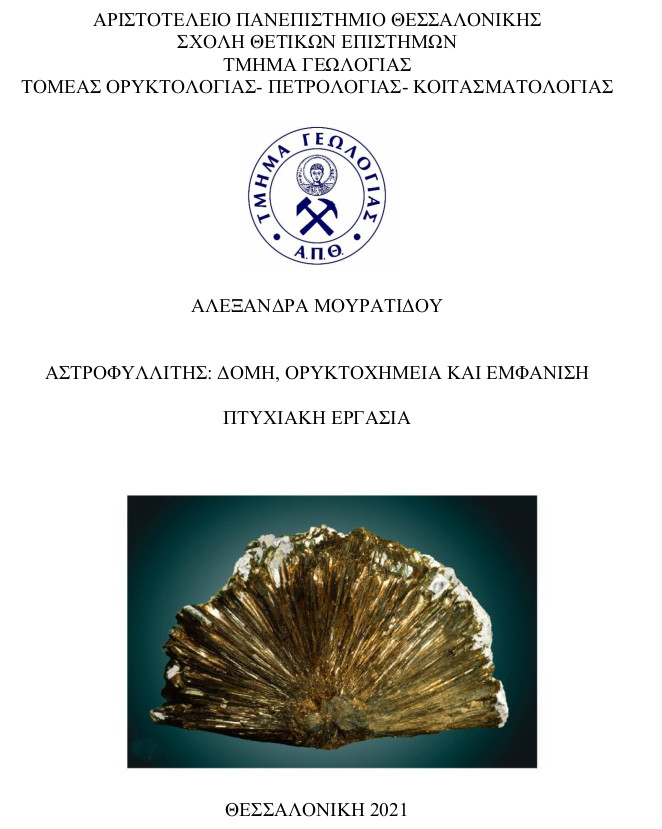
Αστροφυλλίτης: δομή, ορυκτοχημεία και εμφάνιση = Astrophyllite: Structure, mineral chemistry and occurence.
Περίληψη
Ο αστροφυλλίτης σχηματίζει λεπίδες που παραπέμπουν στη μορφή άστρου, από όπου έχει λάβει και την ονομασία του σε συνδυασμό με τη λέξη «φύλλο».
Η λάμψη του είναι στεατώδης, μαργαριταρώδης ή υπομεταλλική. Ο αστροφυλλίτης είναι βαρύς, μαλακός και εύθραυστος. Επιπλέον, η γραμμή σκόνης του αστροφυλλίτη είναι χρυσή.
Τα μέλη της ομάδας του αστροφυλλίτη έχουν βρεθεί σε χαλαζιακούς ή νεφελινικούς συηνίτες, σε αλκαλικούς γρανίτες και σε συνδεδεμένους με αυτούς πηγματίτες. Ο αστροφυλλίτης έχει ανευρεθεί κυρίως σε περιοχές της Γροιλανδίας, της Ρωσίας και της Νορβηγίας. Στον ελληνικό χώρο τα υπό εξέταση πετρώματα δεν συναντώνται και, κατά συνέπεια, ούτε και το εν λόγω ορυκτό.
Ο αστροφυλλίτης ενδιαφέρει κυρίως την επιστημονική έρευνα καθώς, λόγω της περιορισμένης διαθεσιμότητάς του και του υψηλού του κόστους, σπανίως χρησιμοποιείται στο πλαίσιο της διακόσμησης, αν και ενίοτε αξιοποιείται στην κοσμηματοποιία.
Astrophyllite is a very rare silicate mineral of brown to gold-yellow color. It contains iron, titanium and some alkalies. It belongs to a wider group known as the “astrophyllite group”. The general chemical formula of astrophyllite according to IMA is K2NaFe2+7Ti2(Si4O12)2O2(OH)4F.
Astrophyllite typically forms star-shaped blades, from which its name derives in conjunction with the word "leaf".
Τhe lustre of astrophyllite is oily, pearly or submetallic. Astrophyllite is heavy, soft and brittle. Furthermore, astrophyllite’s streak is golden.
The species of the astrophyllite group occur in quartz or nepheline syenites, alkaline granites, and relative rocks. Astrophyllite has been found mainly in Greenland, Russia and Norway. In Greece, these rock types do not occur and consequently, neither does astrophyllite.
Astrophyllite is mainly of interest to scientific research as, due to its limited availability and high cost, astrophyllite is rarely used in decoration, although it is sometimes used in jewelry.
Πλήρες Κείμενο:
PDFΑναφορές
Abdel-Rahman, A. F. M. (1992). Mineral chemistry and paragenesis of astrophyllite from Egypt. Mineral. Mag., 56, 17-26.
Chelishchev, N. F. (1972). Ion exchange properties of astrophyllites under supercritical conditions. Geochem., 7, 856-860.
Christiansen, C. C., Johnsen, O. & Stahl, K. (1998). Crystal structure of kupletskite from the Kangerdlugssuaq intrusion, East Greenland. Neues Jahrb. Mineral. Monatsh., 6, 253-264.
Christiansen, C. C., Makovicky, E. & Johnsen, O. (1999). Homology and typism in heterophyllosilicates: an alternative approach. Neues Jahrb. Mineral., Abh., 175, 153-189.
Ferraris, G. (1997). Polysomatism as a tool for correlating properties and structure. Στο S. Merlino (επιμ.), EMU Notes on Mineralogy, Vol. 1: Μοdural Aspects of Minerals, Notes in Mineralogy (σσ. 275-295). Budapest: Eötvös University Press.
Ganzeyev, A. A., Yefimov, A. F. & Semenova, N. G. (1969). Isomorphism of the alkali metals in minerals of the astrophyllite-group. Geochem. Int., 6, 295-300.
Layne, G. D., Rucklidge, J. C. & Brooks, C. K. (1982). Astrophyllite from Kangerdlugssuaq, East Greenland. Mineral. Mag., 45, 149-156.
Macdonald, R. & Saunders, M. J. (1973). Chemical variation in minerals of the astrophyllite-group. Mineral. Mag., 39, 97-111.
Mineral Data Publishing (2001). Astrophyllite. Ανακτήθηκε από http://www.handbookofmineralogy.com/pdfs/astrophyllite.pdf
Nielsen, T. F. D. (1978). The Tertiary dike swarms of the Kangerdlugssuaq area. Contrib. Mineral. Petrol., 67, 63-78.
Peng, C. C. & Ma, C. S. (1963). [Crystal structure of astrophyllite and a new type of band silicate radical]. Sci. Sinica, 12, 272-276 [στην κινεζική].
Piilonen, P. C., Lalonde, A. E., McDonald, A. M. & Gault, R. A. (2000). Niobokupletskite, a new astrophyllite-group mineral from Mont Saint-Hilaire, Québec: description and crystal structure. Can. Mineral., 38, 627-639.
Piilonen, P. C., LaLonde, A. E., McDonald, A.M., Gault, R. A. & Larsen, A.O. (2003α). Insights into astrophyllite-group minerals. I. Nomenclature, composition and development of a standardized general formula. The Canadian Mineralogist, 41, 1–26.
Piilonen, P. C., Pekov, I. V., Back, M., Steede, T. & Gault, R. A. (2006). Crystal-structure refinement of a Zn-rich kupletskite from Mont Saint-Hilaire, Quebec, with contributions to the geochemistry of zinc in peralkaline environments. Mineralogical Magazine, 70, 565–578.
Piilonen, P.C., McDonald, A.M. and LaLonde, A.E. (2003β). Insights into astrophyllite-group minerals. II. Crystal chemistry. The Canadian Mineralogist, 41, 27–54.
Sokolova, E. (2012). Further developments in the structure topology of the astrophyllite-group 310 minerals. Mineralogical Magazine, 76, 863–882.
Sokolova, E., Cámara, F., Hawthorne, F. C., & Ciriotti, M. E. (2017). The astrophyllite supergroup: nomenclature and classification. Mineralogical Magazine, 81(1), 143-153.
Woodrow, P. J. (1967). The crystal structure of astrophyllite. Acta Crystallographica, 22(5), 673-678.
Zhitova, E. S., Krivovichev, S. V. Hawthorne, F. C., Krzhizhanovskaya, M. G Zolotarev, A. A., Abdu, Y. A., Yakovenchuk, V. N., Pakhomovsky, Y. A. & Goncharov, A. G. (2017). High-temperature behaviour of astrophyllite, K2NaFe72+Ti2(Si4O12)2O2(OH)4F: a combined X-ray diffraction and Mössbauer spectroscopic study. Physics and Chemistry of Minerals, 44, 595-613. Μindat,org. Astrophyllite. Aνακτήθηκε από https://www.mindat.org/min-405.html
Εισερχόμενη Αναφορά
- Δεν υπάρχουν προς το παρόν εισερχόμενες αναφορές.
